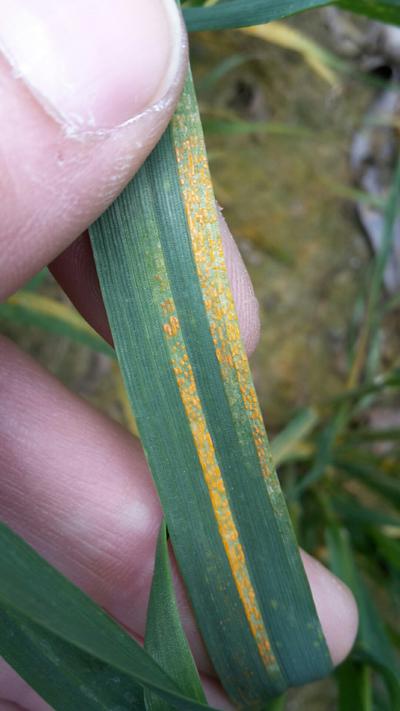Yellow Stripe Rust
Puccinia striiformis
Fungus
In a Nutshell
- Tiny, rusty pustules arranged in stripes.
- Stems and heads can also be affected.
Can also be found in
Symptoms
The severity of the disease depends on the susceptibility of the plant. In vulnerable varieties, the fungus produces tiny, yellow to orange ("rusty") pustules that are arranged in rows forming narrow stripes parallel to the leaf veins. They eventually merge and can engulf the whole leaf, a feature that appears earlier in young plants. These pustules (0.5 to 1 mm in diameter) can sometimes also be found on stems and heads. At later stages of the disease, long, necrotic, light brown stripes or blotches are visible on leaves, often covered with rusty pustules. In severe infections, the growth of plants is seriously compromised and tissues are damaged. The reduced leaf area leads to lower productivity, fewer spikes per plant and fewer grains per spike. Overall, the disease can lead to severe crop losses.
Recommendations

Organic Control
Many biofungicides are available in the market. Products based on Bacillus pumilus applied at 7 to 14 days intervals are effective against the fungus and are marketed by major actors of the industry.

Chemical Control
Always consider an integrated approach with preventive measures together with biological treatments if available. Foliar sprays of fungicides belonging to the strobilurin class provide effective protection against the disease when the application is done preventively. In already infected fields, use products belonging to the triazole family or mixes of both products.
What caused it?
The symptoms are caused by the fungus Puccinia striiformis, an obligate parasite that requires living plant material to survive. Spores are dispersed up to hundreds of kilometers by wind currents and can initiate seasonal epidemics of the disease. The fungus enters the plant via the stomata and gradually colonizes the leaf tissues. The disease mainly occurs early in the growing season. Favorable conditions for the development of the fungus and the infection are high altitude, high humidity (dews), rainfall and cool temperatures between 7 and 15°C. Infection tends to cease when temperatures consistently exceed 21-23°C because at these temperatures the life cycle of the fungus is interrupted. Alternative hosts are wheat, barley, and rye.
Preventive Measures
- Cultivate disease-resistant varieties if available.
- Ensure adequate nitrogen fertilization, avoid excess nitrogen-use.
- Screen fields regularly for volunteer plants and remove them.
- Plow and dig crop residues deep in the soil after harvest.



